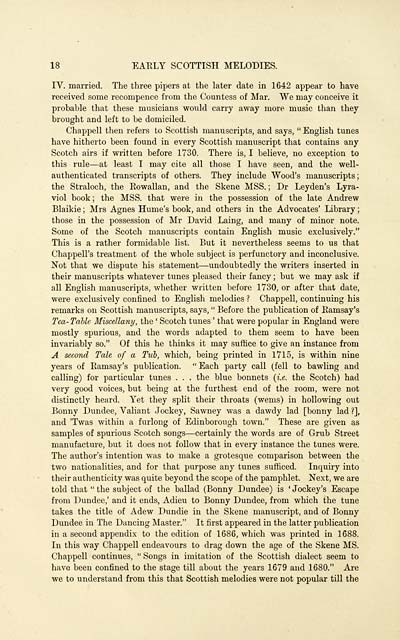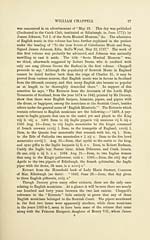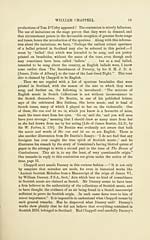Inglis Collection of printed music > Printed text > Early Scottish melodies
(40) Page 18
Download files
Complete book:
Individual page:
Thumbnail gallery: Grid view | List view

18 EARLY SCOTTISH MELODIES.
IV. married. The three pipers at the later date in 1642 appear to have
received some recompence from the Countess of Mar. We may conceive it
probable that these musicians would carry away more music than they
brought and left to be domiciled.
Chappell then refers to Scottish manuscripts, and says, " English tunes
have hitherto been found in every Scottish manuscript that contains any
Scotch airs if written before 1730. There is, I believe, no exception to
this rule — at least I may cite all those I have seen, and the well-
authenticated transcripts of others. They include Wood's manuscripts;
the Straloch, the Eowallan, and the Skene MSS. ; Dr Leyden's Lyra-
viol book; the MSS. that were in the possession of the late Andrew
Blaikie ; Mrs Agnes Hume's book, and others in the Advocates' Library ;
those in the possession of Mr David Laing, and many of minor note.
Some of the Scotch manuscripts contain English music exclusively."
This is a rather formidable list. But it nevertheless seems to us that
Chappell's treatment of the whole subject is perfunctory and inconclusive.
Not that we dispute his statement — undoubtedly the writers inserted in
their manuscripts whatever tunes pleased their fancy ; but we may ask if
all English manuscripts, whether written before 1730, or after that date,
were exclusively confined to English melodies ? Chappell, continuing his
remarks on Scottish manuscripts, says, " Before the publication of Bamsay's
Tea-Table Miscellany, the ' Scotch tunes ' that were popular in England were
mostly spurious, and the words adapted to them seem to have been
invariably so." Of this he thinks it may suffice to give an instance from
A second Tale of a Tub, which, being printed in 1715, is within nine
years of Bamsay's publication. " Each party call (fell to bawling and
calling) for particular tunes . . . the blue bonnets (i.e. the Scotch) had
very good voices, but being at the furthest end of the room, were not
distinctly heard. Yet they split their throats (wems) in hollowing out
Bonny Dundee, Valiant Jockey, Sawney was a dawdy lad [bonny lad ?],
and 'Twas within a furlong of Edinborough town." These are given as
samples of spurious Scotch songs — certainly the words are of Grub Street
manufacture, but it does not follow that in every instance the tunes were.
The author's intention was to make a grotesque comparison between the
two nationalities, and for that purpose any tunes sufficed. Inquiry into
their authenticity was quite beyond the scope of the pamphlet. Next, we are
told that " the subject of the ballad (Bonny Dundee) is ' Jockey's Escape
from Dundee,' and it ends, Adieu to Bonny Dundee, from which the tune
takes the title of Adew Dundie in the Skene manuscript, and of Bonny
Dundee in The Dancing Master." It first appeared in the latter publication
in a second appendix to the edition of 1686, which was printed in 1688.
In this way Chappell endeavours to drag down the age of the Skene MS.
Chappell continues, " Songs in imitation of the Scottish dialect seem to
have been confined to the stage till about the years 1679 and 1680." Are
we to understand from this that Scottish melodies were not popular till the
IV. married. The three pipers at the later date in 1642 appear to have
received some recompence from the Countess of Mar. We may conceive it
probable that these musicians would carry away more music than they
brought and left to be domiciled.
Chappell then refers to Scottish manuscripts, and says, " English tunes
have hitherto been found in every Scottish manuscript that contains any
Scotch airs if written before 1730. There is, I believe, no exception to
this rule — at least I may cite all those I have seen, and the well-
authenticated transcripts of others. They include Wood's manuscripts;
the Straloch, the Eowallan, and the Skene MSS. ; Dr Leyden's Lyra-
viol book; the MSS. that were in the possession of the late Andrew
Blaikie ; Mrs Agnes Hume's book, and others in the Advocates' Library ;
those in the possession of Mr David Laing, and many of minor note.
Some of the Scotch manuscripts contain English music exclusively."
This is a rather formidable list. But it nevertheless seems to us that
Chappell's treatment of the whole subject is perfunctory and inconclusive.
Not that we dispute his statement — undoubtedly the writers inserted in
their manuscripts whatever tunes pleased their fancy ; but we may ask if
all English manuscripts, whether written before 1730, or after that date,
were exclusively confined to English melodies ? Chappell, continuing his
remarks on Scottish manuscripts, says, " Before the publication of Bamsay's
Tea-Table Miscellany, the ' Scotch tunes ' that were popular in England were
mostly spurious, and the words adapted to them seem to have been
invariably so." Of this he thinks it may suffice to give an instance from
A second Tale of a Tub, which, being printed in 1715, is within nine
years of Bamsay's publication. " Each party call (fell to bawling and
calling) for particular tunes . . . the blue bonnets (i.e. the Scotch) had
very good voices, but being at the furthest end of the room, were not
distinctly heard. Yet they split their throats (wems) in hollowing out
Bonny Dundee, Valiant Jockey, Sawney was a dawdy lad [bonny lad ?],
and 'Twas within a furlong of Edinborough town." These are given as
samples of spurious Scotch songs — certainly the words are of Grub Street
manufacture, but it does not follow that in every instance the tunes were.
The author's intention was to make a grotesque comparison between the
two nationalities, and for that purpose any tunes sufficed. Inquiry into
their authenticity was quite beyond the scope of the pamphlet. Next, we are
told that " the subject of the ballad (Bonny Dundee) is ' Jockey's Escape
from Dundee,' and it ends, Adieu to Bonny Dundee, from which the tune
takes the title of Adew Dundie in the Skene manuscript, and of Bonny
Dundee in The Dancing Master." It first appeared in the latter publication
in a second appendix to the edition of 1686, which was printed in 1688.
In this way Chappell endeavours to drag down the age of the Skene MS.
Chappell continues, " Songs in imitation of the Scottish dialect seem to
have been confined to the stage till about the years 1679 and 1680." Are
we to understand from this that Scottish melodies were not popular till the
Set display mode to: Large image | Transcription
Images and transcriptions on this page, including medium image downloads, may be used under the Creative Commons Attribution 4.0 International Licence unless otherwise stated. ![]()
| Special collections of printed music > Inglis Collection of printed music > Printed text > Early Scottish melodies > (40) Page 18 |
|---|
| Permanent URL | https://digital.nls.uk/94643752 |
|---|
| Description | Scottish and English songs, military music and keyboard music of the 18th and 19th centuries. These items are from the collection of Alexander Wood Inglis of Glencorse (1854 to 1929). Also includes a few manuscripts, some treatises and other books on the subject. |
|---|
| Description | The Glen Collection and the Inglis Collection represent mainly 18th and 19th century Scottish music, including Scottish songs. The collections of Berlioz and Verdi collected by bibliographer Cecil Hopkinson contain contemporary and later editions of the works of the two composers Berlioz and Verdi. |
|---|

